History
The early years
The club was founded at a meeting instigated by J J Geake on 10 April 1896 at the Guildford Institute, as the ‘Guildford and Working Men’s Institute (GWMI) Chess Club.’ The first set of minutes state ‘That a Club should be formed amongst the members of the Institute for the purpose of promoting and teaching the game of Chess.’ H S Leonard was appointed as the club’s first President, with Dr F W Clarke appointed as Vice–President.
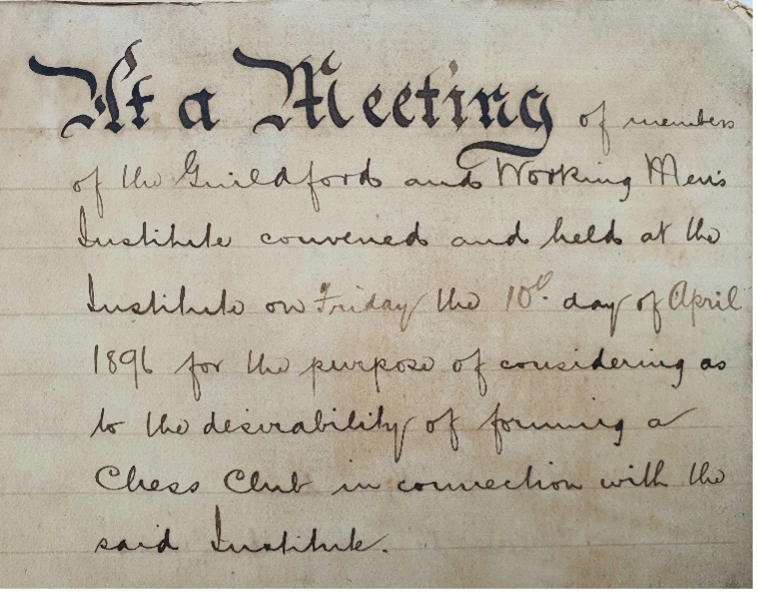
After several further meetings to appoint additional club officers and committee members, and to agree the club’s rules and annual subscription of 2/6d (half a crown), it was agreed that the club would open for play on 5 May 1896.
The newly-formed GWMI Club played its very first match on Thursday 12 November 1896 against a 2nd team from the already established Guildford Chess Club at their home venue at the Station Hotel. The 6–board match began at 8.00pm and was over in about an hour with GWMI losing 2–4.
The first home match was a 6–board double–header against the local YMCA, who at the time were based in North Street in Guildford, on 9 February 1897. GWMI comfortably won by 7½–3½, with one game not finished due to a lack of time – no chess clocks were used in those days! A subsequent return match over 7 boards saw GWMI achieve an even more convincing victory of 12½–1½.
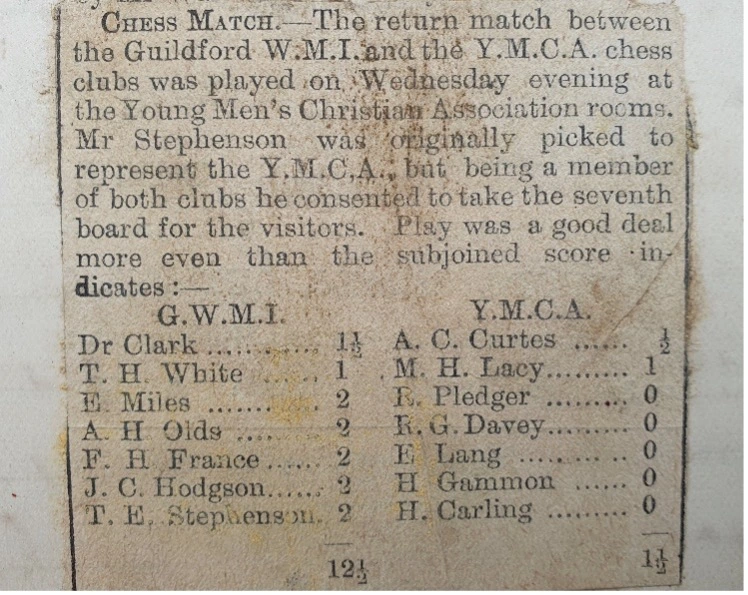
The club’s very first AGM was held at the Institute on 10 May 1897 attended by 9 members with J Phillips (one of the Committee members) in the Chair. The Financial Statement confirmed that the club had 36 members and the first year’s activities had seen the club achieve a surplus of 10 shillings! The club’s first internal tournament was won by Mr T H White, who received a book prize: ‘Staunton’s Chess.’ The 1897/98 season saw various matches played against Woking, Farnham, YMCA and the original Guildford Chess Club with a satisfactory outcome of 6 wins, 1 draw and 2 losses from the 9 matches. It was also claimed that Charles Dodgson (aka Lewis Carroll), who lived in Guildford for a period until his death in 1898, occasionally visited the club.The subsequent years saw a similar schedule of local matches and internal competitive play.
The merger
On 10 April 1899 GWMI amalgamated with the original Guildford Chess Club, which had been in existence since at least 1887 and used to meet in the Station Hotel. It was decided to adopt the latter’s name and to make the Guildford Institute their home venue, which it has remained to this day. The minutes record that ‘The object of the Guildford Chess Club is to play, promote and teach the game of Chess.’ The annual subscription was maintained at 2 shillings and 6 pence.
The newly-formed club immediately registered its first ever league success, by winning the Beaumont Cup (which had only been instigated in 1895/96), with matches over 6 boards being played against Redhill, Wallington and Clapham. Non–league successes were also recorded against Farnham, Charterhouse School in Godalming, Surbiton and Woking, making it a particularly successful season. This early success was in some measure due to the membership including G E Wainwright, the former President of the Oxford University Chess Club and a top British player with international experience.
On 9 August 1902 the club participated in King Edward VII’s coronation procession, by contributing a scene to the Guildford Institute’s tableau car entitled ‘The End of the Game’, celebrating the recent surrender of the Boers. See the photo below, which shows one Club member dressed in the uniform of the Imperial Yeomanry, delivering checkmate to another club member, dressed as a Boer fighter.

The club continued with its activities which included playing league chess in the Beaumont Cup, as well as various friendly matches and running internal tournaments. This was the case for many years, although inter–club competition completely ceased during the Great War, with the minute book reporting '…some of our keenest and best players have joined His Majesty’s forces to help checkmate the German Emperor.' Interestingly the club saw its first lady member join in 1918!
The club celebrated its 25th anniversary in 1920 with an invitation to the legendary José Capablanca (who was to become the 3rd World Champion 1921–1927) to give a 42–board simultaneous display, which he graciously accepted and he unsurprisingly won every game! Capablanca was welcomed by the Mayor, and top British Chess dignitaries such as Edith Holloway, the reigning British Ladies Champion, and former British Champion R C Griffiths, also attended. The club President, R Wells, presented Capablanca with an ivory rook mounted on an ebony pedestal with a silver plate, engraved with the borough arms and inscribed to commemorate the event. Capablanca expressed his great pleasure with such a unique gift, which he would take back home to remind him of his very pleasant visit to Guildford.
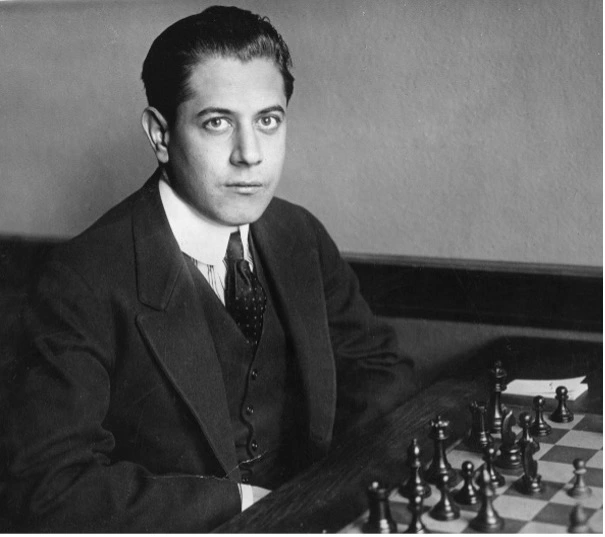
Mrs Edith Holloway, British Ladies Champion, playing 10 simultaneous games at the ‘coming of age’ celebration of the Guildford Chess Club. Inset Mr R C Griffiths, British Champion, who played 30 opponents simultaneously.
(Daily Mirror, photograph)

The club added to its success in the 1920/21 season when it won the Beaumont Cup for the second time, as reported in the minutes of the 23rd AGM in October 1921: ‘After 20 years the Beaumont Cup has been brought back to Guildford …. competing against Aldershot, The Royal Grammar School and Woking.’
The minutes for that year also report on a 9–board simultaneous display given by the well–known Hungarian master Isidor Gunsberg, who had played Steinitz for the world title in 1890/91, losing 6–4 with 9 draws. Gunsberg fared better in the Simultaneous, winning 6, drawing against H F Phillips, and losing to two of the club’s top players, E A Limming and T W White (the son of T H White).
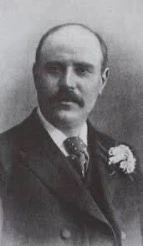
Guildford Chess Club may also have achieved a world first, based on a report in The Wireless World and Radio Review dated 11 November 2022 (see below).
Unfortunately we have no further details, so we do not know whether this was a match against another team, in which case it would be a transmission between two callsigns, or whether it was broadcast to a wider audience. Either way this is highly likely to be a world first for the details of a chess match being transmitted wirelessly, as there are no references to any chess matches being broadcast by radio before 1922.
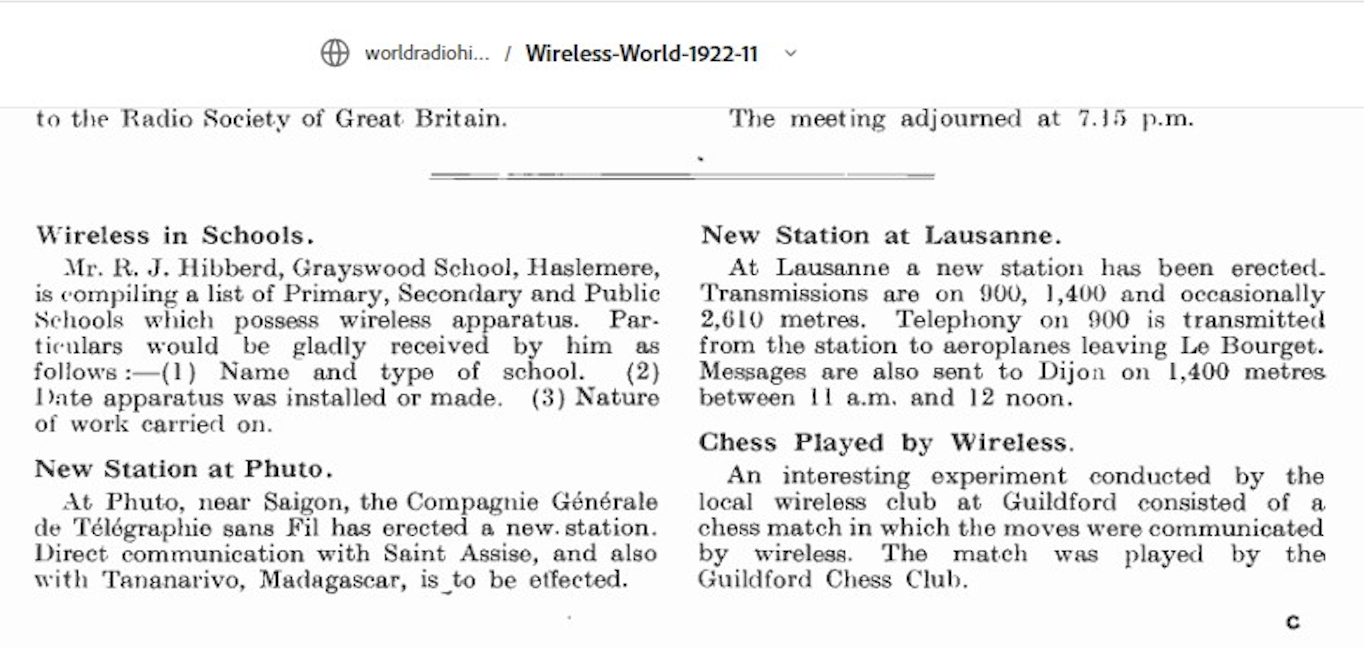
Further league successes quickly followed, starting with winning the Waechter Shield (the equivalent of the Surrey League 3rd Division at that time, behind the Surrey Trophy and the Beaumont Cup) in 1923/24. The club went on to win the Waechter Shield on a further 8 occasions in the years running up to the outbreak of the Second World War in 1939. These successes were aided in part by the strengthening of the club from the development of a junior section (consistent with one of the club’s original objects to promote the popularity of chess), which saw some very promising young talent coming through from the Royal Grammar School. Amongst this talent were two very promising players, B C Gould and A W J Down, both of whom went on to win British Boys Championships between 1929 and 1933. The growing strength of Guildford as a club was further emphasised when in 1929, F D Yates, the reigning British Champion, gave a simultaneous display in London in which three Guildford players achieved impressive results, with B C Gould getting a draw and A W J Down and G T Womack both winning.
The 1930s saw the club’s membership growing. In 1932 the club had two very prominent Guildfordians as vice–presidents, the Right Hon The Earl of Onslow, and the Hon Charles Rhys, the local Member of Parliament. In 1933 the Mayor, Mr William Harvey, also became a vice–president. In addition the club also acquired the services of a very notable problemist G C Holroyd, who was elected match captain in 1933.

A Problem by G C Holroyd which appeared in the West Sussex Gazette in 1929 and won a special award. White to play and mate in 2. The solution is given at the end of the page.
The club continued with its commitment to promoting and teaching chess, when in 1934 Eugene Znosko-Borovsky, the noted Russian Chess master, gave a lecture on ‘General Principles’, which was followed by a consultation match against two of Guildford’s leading players, although sadly it went unfinished due to lack of time.
Guildford’s reputation as a thriving club was further evidenced by an invitation to the reigning British Champion, Sir George Thomas, to give a 25–board simultaneous display at the Royal Grammar School on 13 December 1935. Sir George met strong resistance, winning 17, drawing 6 and losing 2 – a fine result for Guildford members.

During the war years, with less over–the–board activity, the club arranged two correspondence games against Cape Town. The games took eight years (1939–1947), resulting in a 1½–½ win for Guildford. By 1943 the club’s finances had improved somewhat, showing a balance of 5 pounds 4 shillings and 11 pence.
With fewer matches being played, the club arranged a 16–board Simultaneous Display by the veteran German–born British Master, Jacques Mieses, on 30 October 1943, with Guildford players achieving a very creditable 3 wins and 4 draws. Mieses must have been disappointed with this result, as he returned in 1944 to play 18 boards, with Guildford only achieving 2 wins and 2 draws this time!
After World War Two
After the War, the club resumed their winning ways by securing the Waechter shield in the 1946/47 season, the first time it had been contested since Guildford’s last victory in the 1937/38 season. On 5 February 1947 the club also played an unusual 12–board match against a team of German Prisoners of War at the Merrow POW camp, with Guildford winning 10–2. There was a return fixture on 1 July, which Guildford also won by 9½–2½.
The 1946/1947 season also saw the award of The Russell Cup by club member E Russell, for the winner of the Guildford Club Minor Championship, which was won by P C Sergeant. In later years this cup was awarded for the best individual performance in club matches.
Another one–off match was played over 25 boards at Wimbledon Town Hall between Guildford and Wimbledon on 16 October 1948, with Guildford emerging victorious by a score of 16–9.
Guildford continued enjoying success in the Waechter Shield, winning it on a further five occasions between 1948 and 1960, making it a total of 15 victories since its inauguration in 1921/22.
Another notable club member, Graham W Smith, makes his first appearance for the club in 1947 and he became a key member, holding posts such as club secretary and treasurer at various times over a long period.
Doug Williams’s name also appears for the first time in 1949/50 when it was noted that he came third in the Handicap tournament: '… a very commendable score from our youngest player.' Doug went on to make regular appearances for Guildford and became 1st team captain playing on board one for many seasons. In later years he was joined by his elder son Tony who was a regular in the late 1970s.
The minute books of the 1950s also make frequent references to the popularity of playing ‘Kriegspiel’ games on club nights.
Guildford was still an active club in 1954/55 and entered a team in the ‘CHESS’ Postal League. A young member, John Nash, played top board for Surrey Boys during the 1955/56 season and won the club championship in 1957/58.
The 1959/60 minutes report that the club benefitted from ‘… having P C Gibbs, the young Yorkshire and International player, taking part in the later matches.’ Peter Gibbs had been joint British Under–18 champion in 1952 and represented England at the 7th Student Olympiad in Leningrad in 1960 where he lost as Black in an exciting King’s Gambit against future World Champion Boris Spassky. Unfortunately he only played for the club in that one season as he moved out of the area.
The club also staged a 50–board match for Surrey versus Hampshire in Guildford in 1960, with Surrey winning 33–17.
The 1960/61 season saw Guildford winning the Alexander Cup (inaugurated in 1922/23) for the first time, beating Streatham & Brixton in the final by 6–4.
This season also saw another new name amongst the club’s members, Graham R Mitchell, who unbeknown to the membership was the Deputy Director of MI5 from 1956 until his retirement in 1963! Graham, who was a Correspondence IM, played for Guildford up until his death in 1985.
The 1961/62 season was quite memorable in that it saw the formation of the Surrey Border League on 14 August 1961. The Surrey Chess Association presented the Waechter Shield to the newly-formed league, and much to our delight, Guildford managed to win the trophy in its inaugural season. Guildford also decided to enter the Surrey Trophy competition for the first time, having previously spurned it due to the geographical spread of the participating clubs, but it was now viable as it was split into two geographical regions.
The 1970s and 1980s
The 1969/70, 1970/71 and 1971/72 seasons saw some guest appearances for Guildford Chess Club from a well–known England international, Andrew Whiteley, who was attending the College of Law. Although the Border League’s Waechter shield was retained for the sixth, seventh and eighth year in a row, there was no such joy in either the Surrey Trophy or the Alexander Cup.
The 1972/73 season saw several new names playing for Guildford, namely Tony Williams (Doug Williams’ son), G Abayasekera (Roger’s brother) and the well–known Chess historian and author R N Coles, who had written books on Howard Staunton and Sultan Khan amongst others. A new fixture was arranged against Broadmoor, where the match was played under lock and key!
The 1974/75 season saw Guildford entering the Surrey Minor Trophy competition, played over 6 boards, for the first time and winning all 10 of its matches to secure the trophy.
The club organised its second Open tournament on 5 October 1974, which was won by David Pritchard with Roger Abayasekera coming second out of 38 contestants. Neither were club members at the time but both joined the club subsequently and made significant contributions to the club over the years. Half an hour after the tournament had finished and most of the competitors had departed, the Horse and Groom Public House, opposite Guildford Library, was devastated by a bomb which had been planted by the IRA. Four club members were still clearing up and were some of the first to arrive on the scene of carnage.
The 1978/79 season saw the resignation of T W White, the club President, after 23 consecutive years. He had joined the club in 1910 and had only missed four years during the First World War. His link to the club was significant, with his father T H White playing for the original Guildford Chess Club back in 1893 and being an active club member for many years. R N Coles took over from him as President.
In 1980/81 the club decided to purchase a trophy to be named the T W White trophy and awarded for the best game played by a member in club matches or tournaments. Sadly the club President R N Coles died in 1982, having been an active club member for the last 10 years, and a new chess clock, board and set were purchased in his memory. Roger Abayasekera was elected as President at the AGM on 27 September 1982.
In 1984/85 the club won the Surrey Trophy for the first time, as well as achieving its now customary victory in the Border League 1st division. It also won the Border League knockout competition, the Haslemere Trophy, for the first time, after it had been instigated two seasons earlier in 1982/83. It was also reported that G R Mitchell had sadly died.In 1988/89 Graham Smith stepped down as Club Secretary due to ill health, having been an active member for 39 years, and he was appointed to the newly-created position of Honorary Life President, in appreciation of his dedicated service to the club.
The 1990s – a decade of advancement
In 1990/91 the club was strengthened by the arrival of IM Nigel Povah, who was now living in Guildford. This meant that with a stronger Surrey Trophy team, the club decided to enter the Beaumont Cup again, after many years absence, to help bring on some of its younger players. Much to everyone’s delight the club managed to win the trophy, for only the third time, with the previous success being 70 years earlier in 1920/21!
1993/4 was a particularly successful season for the club with it winning the Surrey Trophy for only the second time since 1984/85, as well as winning the Border League 1st division. The club also achieved its best ever performance in the National Club championship by reaching the Final where it sadly lost 4–2 to a strong Paisley YMCA team, but pleasingly receiving the runner–up prize of £500.
This season also saw the club launching a Junior Section driven mainly by Nigel Povah and Roger Abayasekera who created 3 levels of Achievement Certificates for children to demonstrate their progress.
The club staged its second Open Rapidplay event in March 1994 which attracted over 250 entrants and was won by club member IM Nigel Povah, scoring 5½/6.
In 1994/95 the club managed to win the National Club Major Plate competition beating the Royal Air Force in the final 3½–1½.
Guildford vs Royal Air Force
- P. Stimpson 1 P.C. Doye 0
- R. Bryant ½ G.W. Sage ½
- A.K. Punnett 1 R.W. Kermeen 0
- C.A. Wells ½ P.R. Watson ½
- M. Morgan ½ P.R. Kemp ½
The club also won both the Surrey Trophy and the Border League 1st division, as well as winning the Alexander Cup for only the second time.
Roger Abayasekera stood down as President after 14 years and Phil Stimpson was elected in September 1995 in his place.
In the 1995/96 season Guildford Chess Club celebrated its centenary by organising a series of events, which included a 12–board match against the Border League, which the club won 8–4, the restoration of an open–air chess board in the Castle grounds, staging the first Masnou tournament in the UK, and holding a Centenary dinner with IM William Hartston as the keynote speaker.

Outgoing President Roger Abayasekera chatting to the Mayor, with Bill Hartston listening in.
The club capped its celebration by winning the Surrey Trophy for the third year in succession, as well winning the Border League division 2 and the newly formed division 3, receiving the Graham Smith Shield, a most fitting result in remembrance of our long–standing club member.
In September 1995 the club received a last–minute nomination as one of the clubs to represent England in the European Club Championship played at the Barbican. The club managed to win one of its three matches.
The club managed to repeat this feat of representing England the following year in the 12th European Club Cup in September 1996, as was reported in the judges’ recommendation when it awarded the club with the title of the British Chess Federation’s ‘Club of the Year’ in 1996/97. Their recommendation was as follows:
The club is celebrating its centenary in 1996 and claims to be unique in having survived for 100 years without interruption at the same venue – the Guildford Institute. An impressive list of special events has been organised to mark the significant event. The local council has been persuaded to renovate an old chess board which was buried for 25 years within the grounds of the castle, and photographs were submitted showing the pleasing result. It is expected that a plaque commemorating the centenary will be placed on the club building. A celebration dinner was held with William Hartston as guest speaker and sponsored simultaneous events have been held in local schools. The summer will see further significant events including a 'Chess Variants' tournament at Charterhouse School and an open–air simultaneous event in the town centre in July with Steve Davis present, but perhaps the most interesting project is the first Masnou Tournament to be held in the UK, scheduled for June. This is a special kind of rapidplay event without a set number of rounds where one third of the competitors wait to replace losers (or White drawers). Also in June, players from Guildford's twin town Freiburg will visit and attend a civic reception in the town hall. The judges were impressed by the well–developed coaching scheme for junior players constructed by Nigel Povah. This is held for two hours every Saturday morning with certificates being awarded to celebrate stages of achievement. At least one lady player is involved in the coaching. The club has played a very full part in supporting national chess. They represented England in the European club championships at Orebro, Sweden and finished fourth. Guildford were quarter–finalists in the National club championship, semi–finalists in the Major Plate and entered the 4NCL. Locally, the club participates with great success in the Surrey/Hants Border League and Surrey Trophy, and its annual rapid–play event attracts around 240 players, making it one of the largest such events in the south of England. Also of great interest was a fully documented history of the club, compiled by Richard Bryant and Graham Smith which is intended for future publication. The overall presentation of the Guildford entry was clear and attractive, with useful supporting documentation and photographs.
As a result, Stewart Reuben attended the club to present us with an engraved chess clock and he gave a short talk.
Despite 1996/97 being a notable season for the club, unfortunately it did not enjoy any league successes this season, although it did manage to win the Alexander Cup again, as well as the Haslemere Knockout trophy. The club also entered the recently-formed 4NCL (Four Nations Chess League) for the first time under the captaincy of Ian Thompson. The annual dinner was arranged and on this occasion Graham Smith was presented with a plaque to commemorate the 50th anniversary of his club membership.
The club’s Junior section was moved from Saturday mornings to Monday evening between 6–7pm.
In 1997/98 the club won the Border League 1st division again and also the National Club Major Championship, as well as the David Pritchard Shield (the Border League 4th division), which was only instigated in 1995/6. Sadly Guildford’s 4NCL team were relegated into the 2nd division.The 1998/99 season was quite barren for the club with its only successes being winning the Surrey League’s Stoneleigh Trophy (a Rapid Play competition) for the first time and the Haslemere Knockout trophy for the eighth time. There was also some success with Guildford’s 4NCL team gaining promotion back to the first division under the captaincy of Nigel Povah.
In 1999/2000 the club continued in its relatively barren run, retaining the Stoneleigh Trophy and winning the Colin Price Shield (5th division of the Border League) in only its second year. However, it did manage to win the Alexander Cup with a victory over Coulsdon in the final. Guildford’s 4NCL team also progressed, thanks to Nigel Povah sponsoring the team and adding GMs Stuart Conquest, Jim Plaskett, Danny King.
The 2000s
In 2000/01 the club won the Beaumont Cup (the Surrey League 2nd division) for the first time in a decade and retained the Stoneleigh Trophy for the third year running and the Colin Price Shield for the second year running. The club also managed to retain the Alexander Cup for the second year running and only the fifth time in our history by defeating a combined Sutton/Wallington team!
Guildford’s 4NCL team maintained its status as a decent middle–order team in the 4NCL 1st division, and its prospects were further enhanced when Nigel Povah’s company, Assessment & Development Consultants, became the sponsor and the team was rebranded Guildford–A&DC.
2001/02 saw the club winning the Border League 1st division again, as well as the Graham Smith Shield (Border League 3rd division) for the second time.
2002/03 was a very disappointing year with the club’s only success being in winning the Surrey League’s Minor Trophy for only the second time in our history (the first time being in 1974–75), with the competition running since 1951/52!
2003/04 saw the club winning the Surrey Trophy for the first time in the 2000s, although we had a rare disappointment in the Border League first division. However, the most notable achievement this season was Guildford–A&DC winning the 4NCL 1st division for the first time, with a final round 4½–3½ victory over Wood Green, thanks to impressive wins from GMs Emil Sutovsky and Danny King, who scored a stunning 9½/10 throughout the season! IM Alexander Cherniaev also had a good season for the team, scoring an impressive 8/10, which included a solid draw against GM Luke McShane in the final crunch match with Wood Green, enabling him to secure his final GM norm.
2004/05 saw us winning the Surrey Trophy for the second year running, as well as winning the Beaumont Cup again, enabling our second team to be promoted to the 1st division. We also managed to regain the Border League 1st division title but sadly we just missed out on retaining our 4NCL title with Guildford–A&DC only managing to secure a 4–4 draw with our great rivals Wood Green, who won the title on game points. The Guildford squad had no fewer than 14 GMs including World class players such as Peter Svidler and Emil Sutovsky.

The 2004–05 Guildford–A&DC 4NCL squad: L–R kneeling: Maria Yurenok; Danny King; Mark Hebden; Pascal Charbonneau; Joel Lautier; Irina Krush; Emil Sutovsky; Nigel Povah. L–R standing: Jim Plaskett; Jonathan Rowson; Stuart Conquest; Efimov Efimenko; Peter Svidler; Jonathan Shaw; Joe Gallagher; Tony Kosten; David Howell; Glenn Flear.
On a sad note Graham Smith passed away in December 2004, having been a club member since 1947. The Graham Smith Trophy, which he donated in 2002, is used to recognise off the board contributions to the club. 2005/06 was an extremely disappointing year as there were a number of near misses and the club’s only success was winning the Haslemere Knockout trophy.
2006/07 was a much better season, for although there was no joy in the Surrey League competitions, the club did manage to win the Border League 1st division again, as well as winning the David Pritchard shield (4th division) and retaining the Haslemere Knockout trophy. The club also saw Guildford–A&DC winning the 4NCL 1st division for the second time.
2007/08 was similar in terms of limited success, with the club winning the Stoneleigh Trophy and the Tom White trophy (Border League division 2) for only the fifth time. However, further success was recorded with the Guildford–A&DC team retaining its 4NCL title. 2008/09 was a very disappointing year for the club, with only a solitary success in winning the Surrey League’s Ellery Williams Trophy for the first time.
2009/10 saw the club having another poor season in the Surrey League, only managing to retain the Ellery Williams Trophy but enjoying more success in the Border League, where we won the Graham Smith, David Pritchard and Colin Price shields (Border League divisions 3, 4 and 5). Work pressures at Nigel Povah’s company meant they had to reduce their sponsorship of Guildford–A&DC and this impacted on their performance in the 4NCL, with them finishing mid–table.
2010/11 saw only two team successes, with the club retaining the Ellery Williams Trophy for the third year running and the Graham Smith Shield for the second year running. Guildford–A&DC finished mid–table in the 4NCL once again. However, it was pleasing to note that the Junior section continued to thrive with around 20 members, several of whom had qualified for the Chess Challenge Giga Final. A special mention was made of Beatrice Steele, who became the Joint British U11 Girls Champion. This season also saw the arrival of a few new members, with one in particular being Roger Emerson, a long–standing friend and former club–mate of Nigel Povah when they both played for Streatham & Brixton in the 1970s. Roger, who was graded around 200 ECF, added usefully to the club’s playing strength and brought his captaincy and organisational skills, both of which were soon put to good use.
2011/12 was another season with only limited success due to several near misses and the club only managing to win the Stoneleigh Trophy, the Graham Smith shield (third year running) and the Colin Price shield. As Nigel had a few health issues at this time and his company’s sponsorship of Guildford–A&DC in the 4NCL had ceased, Roger Emerson agreed to take on the captaincy of the 4NCL team, which was now renamed as Guildford–4NCL and he started the process of rebuilding the team by becoming the team’s sponsor. Roger brought in GMs Nigel Short, Maxime Vachier–Lagrave, Romain Edouard and David Smerdon and brought back Ety Stefanova but things did not go quite to plan and Wood Green once again emerged on top with Guildford being runner–up.
2012/13 was a highly successful year for the club, with the President Phil Stimpson saying he considered this as the best season ever for the club. In addition to winning the Surrey Trophy, the Border League 1st division and the 4NCL, the club managed to win the Centenary trophy for the first time and the Graham Smith and David Pritchard shields once again. Six trophies! Regaining the 4NCL title after a 4–year gap was particularly satisfying for Roger, who had strengthened the team further with the addition of GMs Gawain Jones, Matthew Sadler, Robin van Kampen and Mark Hebden. The final battle with Wood Green was close fought as always and ended 4–4 but this time it was Guildford who won the title on game points.
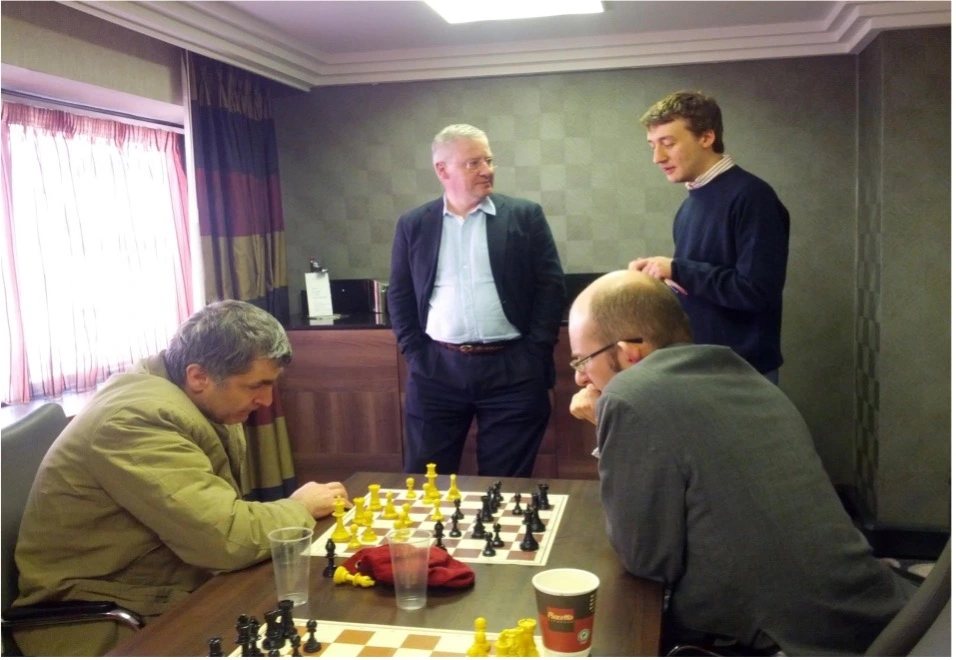
Roger Emerson talking with Luke McShane, whilst Vassily Ivanchuk and Matthew Sadler discuss their game.
In addition to his success with Guildford–4NCL, Roger also enjoyed a personal success, when he came joint first in the British Seniors (Over 60) Championship. This season also saw Nigel Povah returning to active play, after a nine month interval due to illness.
After the highs of the previous season, 2013/14 was much less successful, with victories in the David Pritchard and Colin Price shields (Border league divisions 4 and 5) being the only successes in the local leagues. However, Guidford–4NCL managed to retain its 4NCL title with an impressive 6–2 victory over Wood Green in the final match, thanks to Guildford having two of the World’s top ten playing on the top two boards, namely super–GMs Maxime Vachier–Lagrave and Anish Giri.
2014–15 was a reasonably successful season with our second–ever victory in the Surrey Ellam Trophy (3rd division) and winning the Stoneleigh Trophy, as well as winning the Border League 1st division, the Haslemere Knockout and retaining both the David Pritchard and Colin Price shields. To cap it all, Guildford–4NCL (now jointly sponsored by Roger Emerson and Nigel Povah) retained its 4NCL title, achieving its third success in a row. In addition to these over–the–board successes, the Junior section was continuing to thrive with over 24 members. Some of these juniors played for the adult club in division 6 of the Border League – the Bill Lowe shield, which was named after our former Guildford member and started in 2005/06.
On an individual level, Guildford members enjoyed success at the 2015 British Championships, with Nigel Povah becoming joint British Over–50s Champion and Roger Emerson joint British Over–65s Champion.
2015–16 was another successful season, with the club winning the Surrey Trophy again, for only the eighth time, along with the Ellery Williams Trophy for the fourth time and the Lauder Trophy for the first time, whilst in the Border League we managed to retain both the Haslemere Knockout (for the 12th time) and the David Pritchard shield. Guildford–4NCL also managed to retain its 4NCL title for the fourth year in a row.
2016–17 was a very barren season with only two team successes. The club managed to win the David Pritchard shield for the fifth year in a row and Guidford–4NCL recorded its fifth consecutive victory in the 4NCL.
2017–18 saw the club winning the Stoneleigh Trophy and the Border League 1st division and the Colin Price shield. Guildford–4NCL also won its sixth consecutive 4NCL title.
2018–19 saw the club winning the Stoneleigh Trophy for the eighth time and the Beaumont Cup (Surrey 2nd division) for the sixth time, with the first victory in this competition being back in 1899/00! The club also won the Border League 1st division for the 31st time, the Graham Smith shield for the seventh time and the Bill Lowe shield (6th division) for the first time! Not to be out done, Guildford–4NCL won its seventh consecutive title, with the team now having achieved a stunning 81 victories and only two draws over the last eight years! When added to the three earlier successes of the Guildford–A&DC team, Guildford can claim 10 titles in the 4NCL’s 26 year history, making it by far the most successful club in the 4NCL.
2019–20 saw the temporary demise of over–the–board chess due to the Covid pandemic, so Guildford turned its attention to playing online chess in the 4NCL Online league. Guildford fielded a team of youngsters in a team called ‘Guildford Young Guns’ which achieved a very creditable result, being the losing finalists in a strong competition.
2020–21 followed the same pattern as the previous year with the pandemic still preventing OTB play. Once again the Guildford Young Guns performed very well but was once again the Bridesmaid and not the Bride! However, Roger and Nigel decided to sponsor a Guildford–4NCL entry in the European Online Club Championship. Our five–board squad comprised England’s top four, Mickey Adams, David Howell, Luke McShane and Gawain Jones, plus Bulgarian GM Ivan Cheparinov, all of whom had played for Guildford in the 4NCL over the last two to three seasons. The team was seeded third out of over 90 entries and it easily qualified for the final stage of the tournament with the top ten best teams. However, unfortunately it failed to live up to its seeding at this point and ended up in a disappointing seventh place.
Solution to Holroyd’s problem: 1.Qf1! Any (1…exf1=Q/R/B 2.Rd2#; 1…exf1=N 2.Nc1#; 1…Kxc2 2.Qb1